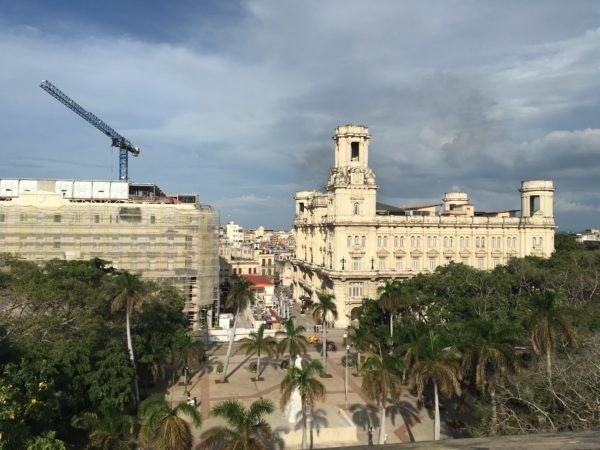
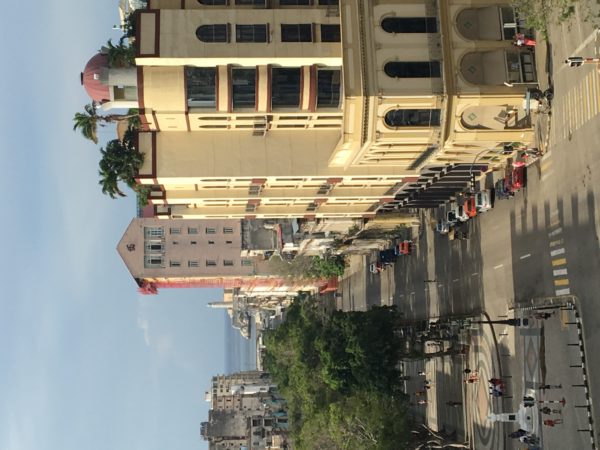

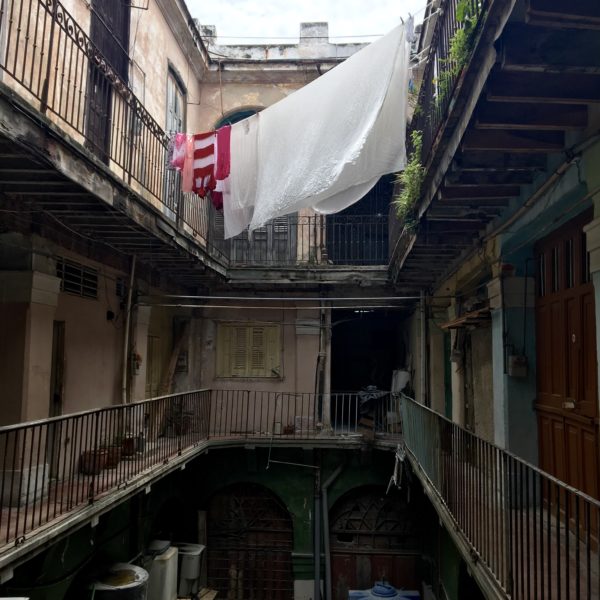
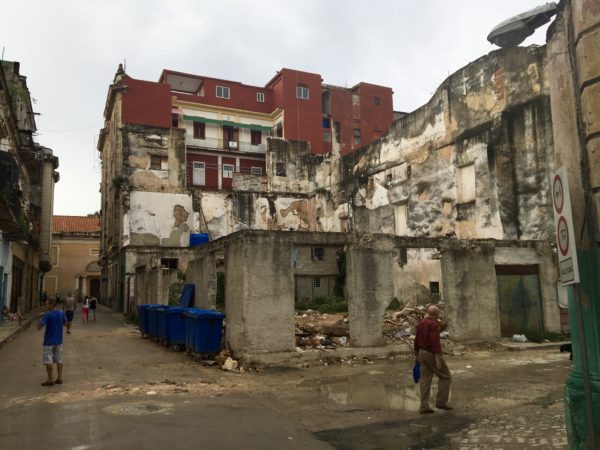
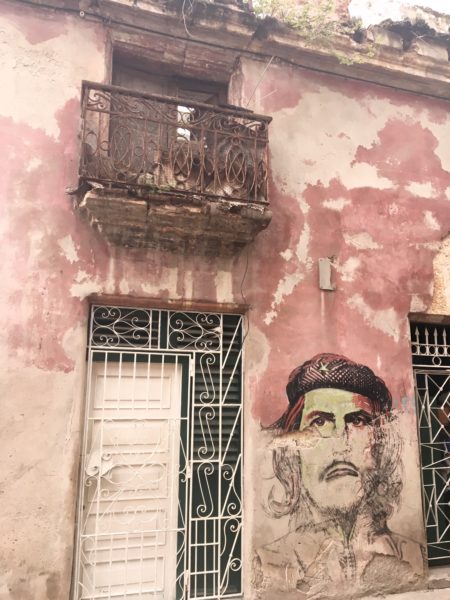






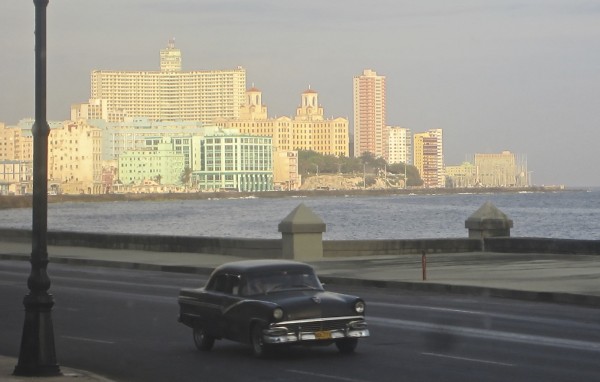
Perhaps because it is August and the long days of oppressive tropical sun simulate a photographic effect of a landscape overexposed. In Havana where, on my past six visits in 3-1/2 years, stark contrasts have been obvious, now few contrasts seem evident. All is worse than before. Even the glorious colonial restorations of portions of Habana Vieja do not disguise the general state of disintegration of all the tens of thousands of other edifices, housing the nearly 3 million residents in generally horrific conditions of squalor. Even the office of the City Historian admits buildings in Havana are collapsing at the appalling rate of one a day. The main arteries are lined with people, arms outstretched, trying to hail a community taxi or guagua (bus) that might squeeze in one more person. A commute to and from work – always a challenge – can take even more hours than before. Shop and office times are abbreviated to save electricity, and perhaps, most telling of an energy crisis is that air conditioning at the arrivals terminal at José Martí International Airport has been turned off until further notice. Welcome to Cuba.
Every time I’ve arrived, the process has been different. The first time, a young Customs officer in mini skirt and fishnet stockings cornered my friend and me and wrote on her clipboard our repeated answers to why we were there, where we were staying and what we planned to do. The second time, arriving with a cultural visa as a guest of the Cuban Book Institute, I was detained for bringing 50 USB thumb drives, with data on self-publishing recorded on each to give to the publishers and editors who were officially invited to attend my workshops. But even the sanction of the Ministry of Culture could not save me from two hours of bureaucratic absurdity as five functionaries wrote and transcribed my story, counted and recounted the 45 Drives ( I was permitted 5) and confiscated them securely in a large canvas sack. The Book Institute’s attorneys eventually freed them but the inconvenience to all was extraordinary, and yet “Normal.”
Subsequent arrivals included long waits at immigration, being detained at “Aduana” (customs) for declaring $75 in gifts, which cost me $27 in taxes but, moreover, more than an hour trying to pay the fee. Word to the wise: DECLARE NOTHING! (Unless you’re bringing in a big screen TV or the like). This time, there was no wait at Immigration (albeit, I was in the front of the Interjet flight from Mexico City). I was not asked for proof of health insurance, as in previous arrivals. I was asked if I wanted my US passport stamped, whereas before it was routinely not done. Then, I put my carry-on bags through the screening process and went to wait for baggage to arrive at the carousel. There are free carts and soon my 3 suitcases were wheeled through the final checkpoint, I handed in my “nothing to declare” customs forms, the magic doors slid open and there I was, back in La Habana. Seamlessly, miraculously, and likely never to happen so smoothly again.
As I chose to substitute a new iPad for the heavy MacBook Pro I usually schlep on trips, I am unfamiliar with how to use it and therefore photos may be lacking in any reports over the next few weeks here, as I catch-as-catch-can a hour at one hotel or another to access internet. Please bear with me.
Every time I arrive, I ask the taxista who drives me from the airport to “my room” at the home of my adopted family in Vedado (which everyone agrees is the best neighborhood in which to live; especially those who live there), “What is changing in Havana?” Usually, the answer is, “Nothing changes here.” This time, the driver said, “We’re in a petroleum crisis.” I knew this from the many notices and online magazines I receive, but I was unprepared for how bad it is. As if to squash any hope offered by the ‘reapproachment’.
Americans are ridiculous when they say, “Go to Cuba now, before it changes!” They lack all understanding of the depth and complexity of the almost 60 years of failed communism. Every aspect of society here needs help — from infrastructure to economic systems to distribution to access to basic medicines to, most desired: internet access. How and where would you begin to build upon rubble, when there are are no materials and little expertise? It’s is a situation of increasing despair.
And while we’d expect some disparity between prices of goods and services from those paid by locals and tourists, the disparity here is multiples of difference, and the “worth” of anything is unknown. Do not romance this beautiful island full of genuine and gracious people, as life remains extraordinarily difficult for almost everyone here.
Meanwhile, I will continue to look for signs of hope but, as of this first week back among my beloveds, I am more discouraged than on past adventures.
This post is from the introduction to my book in progress, “Cuba Stole My Heart.”
Please consider joining me and a group of friends for the next
“Journey for the Creative Spirit!” to Havana
Nov. 30-Dec. 8, 2016.
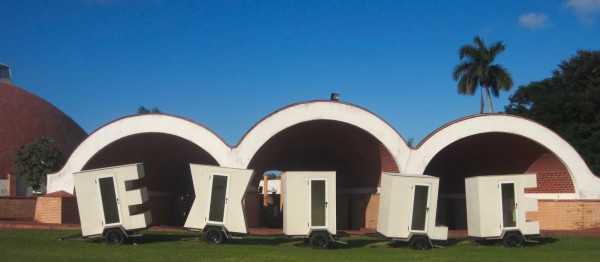
Cuba embraced me and I returned with a kiss. It was spontaneous, unimagined, unbidden… at least on a conscious level. Since my first visit, March 2013, I became enraptured, entangled and connected. My best friends, valued acquaintances, two adopted families, and baby godson live there. But for a chance encounter, a moment in time/space that cracked open, I would not have been ushered into this astonishing and complex world which has become an integral part of my life.
Without Latin decent and having lived and traveled extensively in the English-speaking world, Cuba was never on my mind or in my heart, as it is for all exiles. So I am surprised and delighted to find myself so deeply intrigued and absorbed by this society ostensibly on the verge of change.
I suspect my personal connection lies in fascination with those who have stayed through all the challenges and deprivations of the revolution, committed to home-as-place and family, a sense of belonging I’d sought but had evaded me. And I relate to the perennial Cuban struggle for identity as a people, a community and society, as it too is part of my search.
This is the story of my Cuban experiences over 3 years and five visits totally 6 months. It is not a guidebook in any traditional sense, although I hope you gain insight and guidance to serve if you are planning a trip to Cuba, or simply enjoy a personal journey informed by this island nation, which even its own citizens rightly describe as “complicado.”
 Or Why Taking Responsibility – That Isn’t Yours – Can Be Detrimental To Your Health!
Or Why Taking Responsibility – That Isn’t Yours – Can Be Detrimental To Your Health!
On the red metal bridge designed by Gustave Eiffel, over the River Onyar in Girona at sunset, walking with my friend Anna, a man, thirty-something, with a jaunty walk, approached from the opposite direction. Recognizing Ana, he slowed and exchanged greetings. “Que tal?” she asked. He said he’d just come from teaching a voice class. He cradled a bottle of Dom Perignon, and I commented that was a precious bottle. “A gift from one of my students,” he said, with a smile that conveyed genuine gratitude. He was relaxed and completely present to our conversation.
“So you teach singing?” I asked. “Not exactly. I work with professional singers, yes, and others, to find and expand their voice, which comes from their body, their grounding.” Jordi Hom continued, speaking of the relationship of the body’s organs to the body and its surroundings, using all its senses – including its intuitive sense – to give rise to voice. “It has little to do with just breathing.”
Without thinking, I asked, “Can I have a session with you?” I surprised myself. “Sure,” he replied and we made a date. The night before, I had a Skype talk with a new friend, who is a talented jazz singer. We spoke about the joy of singing, and my inhibition, believing I cannot sing on key. “You have a great speaking voice. I’m sure you can sing,” she said. I wasn’t sure, although I love to sing and know the words to nearly every song I’ve ever heard. And then this teacher appeared. Serendipity.
Jordi’s studio is a spacious room with a mirrored wall and electric piano in one corner. I stood in the middle while he walked around me, observing. “Your energy is cut off at the knees, ungrounded. It’s not flowing through your tightened chest, through your groin and connecting with the ground,” he said.
He sat at the piano and had me sing scales using different vowels. “You have no problem with key,” he noted, “but do you hear all the air in your voice?” Of course, it’s sounded like that for as long as I recall, as if diluting sound with air. “Let’s change that!” he said with glee. OK! I agreed.
For the next hour, I walked deliberately, planting my heels on the floor, moving my arms and hands in loose circles toward my body, I sat in a chair across from him as he massaged every centimeter of each hand, moving the energy up my arms, explaining how the meridians related to various organs. At one point he said, “You’re carrying responsibilities that are not yours.” As the truth of that was obvious to me, I began to weep.
I had a lifetime of stories of hurts, disappointments, abandonments… persistent memories of being wounded. I had literally taken to heart other people’s words and deeds, let them stick like a knife, drawing my life’s blood. And I carried responsibility for them, as if they were my words and deeds when, in fact, I know that everything that issues from another is theirs. I have my own. I didn’t need to take responsibility for anyone else’s. It was a heavy and painful burden that finally and suddenly could be let go. My body relaxed in a new way.
I returned several times to stand in front of the piano and intone scales. As if a miracle, I heard my voice without airiness, a pure deep rich tone. Jordi played “The Rose,” a perfect song for the occasion, and I sang, tears streaming down my cheeks. “You have a beautiful voice,” he said. Yes, I do. It’s always been there, a secret even to myself. Now it is revealed. 
Interesting that this happened in Girona, a city renowned for its secrets hidden in massive stone walls, buried beneath ancient foundations. We all have wounds. That’s inevitable. But in relinquishing responsibilities that are not mine, my voice became clear.
“The Rose”
Some say love, it is a river
That drowns the tender reed.
Some say love, it is a razor
That leaves your soul to bleed.
Some say love, it is a hunger,
An endless aching need.
I say love, it is a flower,
And you its only seed.
It’s the heart afraid of breaking
That never learns to dance.
It’s the dream afraid of waking
That never takes the chance.
It’s the one who won’t be taken,
Who cannot seem to give,
And the soul afraid of dyin’
That never learns to live.
When the night has been too lonely
And the road has been too long,
And you think that love is only
For the lucky and the strong,
Just remember in the winter
Far beneath the bitter snows
Lies the seed that with the sun’s love
In the spring becomes the rose.
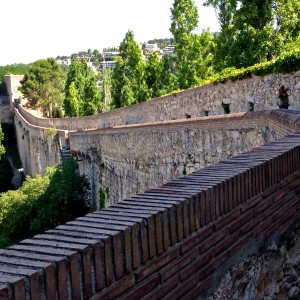 After walking the ancient wall that encloses the original city of Girona, Catalonia, I returned to my computer to find an article, “68 Thoughts Every Traveler Has On Their Trip Around The World” by Nomadic Matt, one of the many travel writers to whom I happily subscribe. He does a great job at encouraging his peers to “travel cheaper, better, and longer.” While his article appeals and applies to a 20-something beer-drinking, hostel-staying crowd – the ones I met 35 years ago – it inspired me to wonder if I could make a list of “68 Thoughts A Baby-Boomer Woman Traveler Has When Traveling Alone.” Why not?
After walking the ancient wall that encloses the original city of Girona, Catalonia, I returned to my computer to find an article, “68 Thoughts Every Traveler Has On Their Trip Around The World” by Nomadic Matt, one of the many travel writers to whom I happily subscribe. He does a great job at encouraging his peers to “travel cheaper, better, and longer.” While his article appeals and applies to a 20-something beer-drinking, hostel-staying crowd – the ones I met 35 years ago – it inspired me to wonder if I could make a list of “68 Thoughts A Baby-Boomer Woman Traveler Has When Traveling Alone.” Why not?
Matt wrote his list in the third person; mine is first-person and I would not presume or generalize about anyone else’s experience. Although I have had some times of loneliness, I am pleased to note I’ve had no regrets about embarking on this journey, I have been supported in countless ways by human angels at every turn, and have faith I will find my way “”home” and inhabit my dreams all along the way.
Your comments, as always, are welcome. As Iggymo would say, smiles and love.
68 Thoughts A Baby-Boomer Woman Traveler Has Traveling Alone
1. I’ve done this before, I can do it again.
2. This time I am more mature, have more skills and contacts and know-how to plan and budget.
3. I know it’s important to travel light, but damn, I need these 5 pairs of shoes because I have bunions and my feet ache and I need to have alternatives.
4. I will be traveling to various climates and have many experiences, so I need a variety of clothes for warm and cool weather, informal and more formal.
5. I need these hair and body products, this makeup, these over-the-counter drugs just in case… it’s a lot to carry, but important.
6. OK, so I fit everything into 2 rolling bags that weigh in just below the airline limit (25kg each). No matter, I can hire porters and airport carts.
7. There are no porters and airport carts. My bags are way too heavy.
8. I’m afraid I’m going to strain a muscle.
9. Why is there no one to help me?
10. Why did I agree to stay in a 4th floor walk-up without an elevator?
11. Oh well, it’s for a few weeks and I only have to carry them up and down once.
12. Yay! I am in Madrid!
13. It’s a beautiful city I’ve been in twice before and know my way around.
14. There are people everywhere, and I am lonely.
15. I attend InterNations events and get together with a few people. Well done, making new friends, seeing the sights.
16. I am still lonely.
17. I need to make more friends.
18. I do. Good, interesting people. Good for me.
19. This is the first stop on what may be a long journey in search of home. I chose this. Be patient.
20. Love yourself.
21. Everyone thinks you’re courageous.
22. I’m not. I want to see if it’s true what I’ve been telling others: that you can “Inhabit Your Dreams!” Can you really? Can I?
23. Damn, I spent a lot of money on clothes, thinking I needed to buy them before I left, only to discover I could have bought better, cheaper, more interesting clothes in Madrid.
24. I’ll give away everything I don’t need and then my suitcases will be lighter.
25. Two bags of clothes and toiletries gone to the woman who cleans the hallways, and still my bags are full to the max and too heavy. How can this be? What else can I give away?
26. Why did I bring all those toiletries and medicines? I can buy almost everything I need when I need it.
27. Why did I bring a router and printer? I thought I’d need them for my work, but this is Europe and there is wi-fi and copy shops are everywhere. Get rid of them.
28. I give them to friends to use, with the agreement I can have them back if I need them. Why would I need them? Stop hanging on to things for some imagined contingency.
24. I carry the still-too-heavy bags down 4 flights of stairs, one at a time, at 7 a.m. Why is there no one here to help me?
25. I could hurt myself.
26. I do not know how to travel light.
27. Why is the taxi I reserved not here to take me to the train station?
28. I could miss my train and keep a friend waiting who is driving a long way to meet me. How would I get in touch with her? I haven’t figured out how to call France from Spain on a Spanish cell phone.
29. I am pathetic.
30. I will leave all my things in the hallway and hope no one steals them while I run around the corner and hope to find a taxi. Am I am idiot?
31. I find a taxi. I am OK. I am resourceful.
32. Strangers help me with my over-weight bags. I am blessed.
33. My new friend is at the Bayonne station to meet me. All is well.
34. I stay at her beautiful home in the French countryside. I am so lucky. How can two weeks pass so quickly? I didn’t get much done.
35. I am much more relaxed, at peace with this path I’ve set for myself.
36. I am organized.
37. I leave more things behind but my bags are still too heavy.
38. I am on my way to Girona, where I have wanted to go for years, and with a great place to stay, thanks to more great people in my life. It’s all good.
39. There is a French railroad strike and I cannot use the ticket I bought weeks ago to Girona. Now what? Why is this happening to me?
40. There must be another way to get there. Yes, a bus at midnight getting me in at 4 a.m. OK, I’ll deal with it. I buy the bus ticket. Whew. I’ll email my friends in Girona.
41. Fuckin’ internet at the station doesn’t work (“Sorry for the inconvenience” says the online message). I am being foiled at every turn. Am I not supposed to go to Girona? Stop with the “magical thinking,” it’s just a railway strike!
43. I find a wifi signal and get through to them. They are very helpful and consoling. Relax. All is well.
42. Can I just retreat to the comfort of my friend’s nice house in the country? No, you must carry on. Remember how courageous your friends think you are.
43. Thank god there is baggage storage next to the train station. I wheel my bags, piggy backed. It works on flat paved ground. Pretty cool.
44. Now what? I break down and cry. Why am I all alone? This is too much.
45. You’re in Toulouse. You were here before in 2008, as a journalist guest of the Tourism Board. You can rent a city bike. You have a Mexican credit card with a chip in it that should work. You are so smart.
47. With help from other bike renter, you figure it out. It works. Now ride around and see what you can discover. It’s a beautiful day. All is well.
48. I wave at kids on a boat on the river and stop to buy a bottle of water. A young French man and I get into a conversation. He is a filmmaker, lived in Australia, is full of ideas. We talk for a hour. He takes a photo of Iggy and me and the bike. How sweet! Life is full of good things.
49. The gazebo at the park is full of dancing couples, the sidewalk cafes full of friends. It is beautiful and I feel lonely.
50. The bus is full and cramped. How have I managed to travel widely and this is the first time ever that my plans have been derailed? I guess I am lucky.
51. I am in Girona. My friends make me feel very welcome. But they are leaving for the weeks I will be here. I will be alone.
52. This is a beautiful apartment they have given me. I feel grateful.
53. The city has so much history and places to explore. I can take care of myself here, see what I want, do what I want.
54. I don’t really care about churches and museums. I’ve seen a lot of them. What am I really interested in and when am I going to finish writing the two books I have in process?
55. I get out and walk around, talk to people, use “my companion” IggyMo as a device. Some moments are interesting, engaged. I stop and interact. I am good at this.
56. There are many shops with beautiful things. I don’t need to buy anything. It’s strange not having a home in which to put beautiful things.
57. The bread, pastries, wine and chocolates are fabulous and cheap. I am enjoying them all and hope I don’t gain weight.
58. That’s what happened 35 years ago when I traveled in Europe alone. But I was scared then. I’m not scared now, just missing having someone to share all this with.
59. I have coffee with a neighbor. How nice!
60. He has a life. I don’t. But I am just getting started creating this new one. Be gentle with yourself.
61. I am good at distracting myself with Facebook, with work, with writing this list.
62. Remember: this is what many people dream of doing. This is what you said you dream of doing!
63. I feel grateful for my freedom, for the many friends around the world who think of me, care about me, allow me to care about them. How blessed I am!
64. I will take myself to the coast tomorrow, as it will be hot and sunny and I want to go to the Costa Brava, the Brave Coast. I want to be brave.
65. This is my life, my human experience. I am fortunate to be here, to look out over this beautiful historic city of Girona and have so many adventures ahead.
66. I could go to a jazz club tonight, but I am too tired.
67. I think of going to Barcelona for a day or two, as it’s so close, but it seems exhausting. I was there for a week in 2006 and I have no desire to sightsee. Too many people. Better to stay in a place, ideally for a month of more.
68. In 2 weeks I will train to Paris (if there’s no train strike) and meet up with one of my oldest, dearest friends and, for that week, and the next with another friend in Burgundy, I will share the experience and appreciate not being alone. I will get rid of even more stuff, and little by little my luggage must surely become lighter.
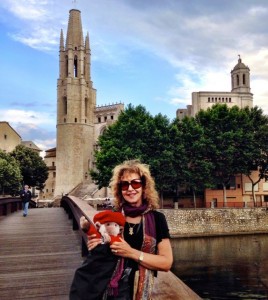
Hello, I’m back. The passing of this summer Solstice, which finds me in Girona, Catalunya (northeast Spain), seems a perfect time for committing or recommitting to what is important.
There is so much I want to write about, to share, in the European adventures I’m having, in the new life I am creating at 59 years old. This isn’t just a vacation or a trip, as that implies a finite amount of time and a home that awaits your return. I currently have no such place, such anchor, in the world.
I did not realize three years ago (and more), as I began to dismantle my partnership of 25 years – through lack of appreciation and an abiding sense of discontent – that I was setting myself on this path to discover “home.” It is, of course, both an internal metaphor – a journey of where sense of purposefulness, meaning and connection reside – and an external search for a physical location where I feel “at home.”
As a writer, words (increasingly spoken aloud to my solo self) are the means by which I process and communicate with myself, and others with whom I hope to be in conversation. Therefore a blog is an appropriate and valuable tool, which I’ve not employed in a long time. There are always distractions, excuses and choices to be made about how we pass the hours of each day.
In addition to being present with the newness that travel imparts, I’ve been spending a lot of time on FaceBook creating a community for my travel companion, IggyMo who is a stuffed monkey made by Gund and purchased for me 27 years ago. He now has over 100 fans and, like any novelist will tell you about characters taking on a life of their own (which you hope they do), IggyMo is doing and saying things that are unique to him. He’s a delightful companion who permits me to share his daily adventures at http://on.fb.me/STqio3. Iggy would love if you’d like his page and subscribe to “notifications” of new posts.
As I left San Miguel de Allende the end of April on this journey to Europe, in search of “home” and to inhabit my dreams, I’ve been trying to organize and refocus my website and this blog. I still have a long way to go, to put all my professional work on to my personal site and use this blog for my travels, both inner and outer. Between that and online work, for which I am very grateful to my client of 2+ years, Mr. Paul Merriman, I have had good excuses for not blogging.
No more excuses. I recommit. And, if I want to know what I’m committed to, all I have to do is look around at my mirror of my thoughts, feelings, actions (inactions) and interactions. The responsibility is all mine. This feels good.
How are you feeling about your commitments?
If you are a subscriber, thank you! I hope you will share this site on your social media and among friends, and will write a comment, even if briefly, so I know you’ve been here, are with me, which means so much!
I hope you enjoy my first post back, which will post immediately after this: “68 Thoughts A Baby-Boomer Woman Traveler Has Traveling Alone.”
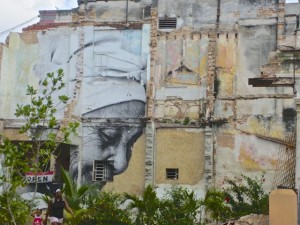 Nearly 3 million visitors went to Cuba in 2012 – from Canada, U.S., South America, Europe, Asia, Australia… well, just about everywhere. It’s a beautiful, diverse, dynamic and complex country that welcomes tourists with increasing services and amenities. And beyond tourism, Cuba is a fascinating society in transition. Citizens around the world know they can visit Cuba without any restrictions other than the normal visa process, but most U.S. citizens do not believe they can. This is a myth.
Nearly 3 million visitors went to Cuba in 2012 – from Canada, U.S., South America, Europe, Asia, Australia… well, just about everywhere. It’s a beautiful, diverse, dynamic and complex country that welcomes tourists with increasing services and amenities. And beyond tourism, Cuba is a fascinating society in transition. Citizens around the world know they can visit Cuba without any restrictions other than the normal visa process, but most U.S. citizens do not believe they can. This is a myth.
U.S. citizens can legally go to Cuba under several programs:
• Academic/Cultural/Volunteer Tours (search: travel to Cuba, trips to Cuba). I recommend educational/cultural/agricultural trips organized out of Mexico by www.globaljusticecenter.org
• Under the “General Licenses” law of the U.S. Treasury. You do not need to apply; you just need to qualify. If you qualify as a “professional” or other category, you can fly to Cuba from Canada, Mexico, Europe or elsewhere. Read the U.S Treasury rules here.
• Via charter flights, if you have family in Cuba.
First, I want to answer some of the most frequently asked questions, and then provide links to explore. To view my YouTube photo slideshow of Cuba, with music, click here.
Will they stamp my passport?: Cuban immigration will not stamp your U.S. passport. Instead, they issue a paper visa which you return upon departure. There is an exit tax ($25 cash), so make sure you hold back some Cuban currency to pay this at the airport.
• Health insurance: You are required to buy health insurance. Your U.S. health insurance or credit card travel insurance will not apply.
You can and must purchase Cuban health insurance. It is available for purchase at airport arrival before getting in line for Immigration. For $3/day, it’s a bargain should you need it.
• Money: You should bring sufficient cash for your stay. All major world currencies can be exchanged for Cuban CUCs (roughly equivalent to $1 US). You will be charged a 10% premium for converting U.S. dollars, so you may want to consider having a different currency to exchange. Currency exchange should be done at the airport. There are banks and exchange houses in the major cities. Your U.S. credit cards cannot be processed in Cuba. For more on Cuban currency, read my last blog. 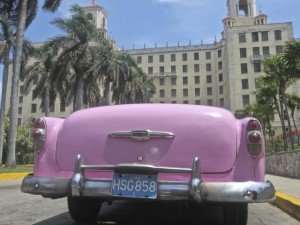
• Accommodation: You should arrange beforehand where you will stay and have a print out of your reservations to show if asked by immigration or customs. Hotels like The National (where the ghosts of Batista-era mobsters and celebrities are capitalized upon) or the Seville (a Mercure-Accor hotel in old town Havana where Graham Green is reputed to have written “Our Man in Havana” – Room 501) may be worth the tariff, but for a “real Cuban experience,” I recommend the privately-owned “casa particulares“. Google that term for plenty of listings and reviews. Figure $25-$40 per night for a double room with its own bathroom.
• Food: “I’ve heard the food isn’t good…” say most Americans, who ironically hail from a country that invented and exported high-carb, high-sugar, high-processed, diabetes-inducing fast “food.” The typical Cuban diet is basic but real – rice, potatoes, a little green, a little meat or fish; the pervasive ham sandwich on white bread; pizza. But there are fine restaurants with world-class chefs, excellent seafood, fruit drinks, fabulous desserts and some of the best coffee in the world.
Searching For Resources:
Before I went to Cuba in April 2013, I searched “Google” to find as much contemporary information as I could. I didn’t find much and erroneously concluded there wasn’t a lot about Cuba online. But there is! Like any online search, it’s a matter of what keywords or phrases you enter, and each one will give you a different set of results (websites) corresponding to that word or phrase. Be creative in your search terms, and remember that the embargo and blockade are unique to the U.S. government. Here are some places to begin:
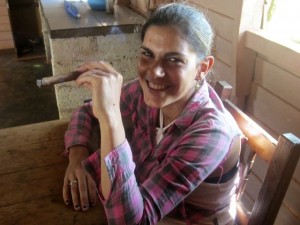 General information sites:
General information sites:
Cuban Tourist Board in Canada
Tripadvisor.com – recommendations and ratings from fellow travelers; browse site
Lonely Planet – fabulous forums – Buy their latest guide!
www.cuba-junky.com – resources and self-guided walking tours
Cuba Travel Agency & Tour Operator
Articles:
Many academic articles on the various complex aspects of Cuban society: http://www.globaljusticecenter.org
Search major newspapers in the UK (Guardian), Canada (Vancouver, Toronto, Montreal), Australia.
Exploring Havana is easy – Monteal Gazette
Travel Cuba – The Montreal Gazette
Tripadvisor.com: Activities in Havana
11th Havana Biennial Attracts Americans – NY Times.com
20 great things to do in Havana – Time Out Travel
Where Is Cuba Going? – NY Times.com – Excellent, lengthy article by a U.S. journalist married to Cuban living in the U.S.
Beginner’s Guide To Cuban Travel (from Australian news)
The Truth About Socio-Economics in Cuba – great article by Chris Turner in The Walrus.
Best Blog about Life in Cuba, by U.S. travelwriter Conner Gorry, who has lived there since 2004. She just started Cuba Libro, Cuba’s first English language bookstore-cafe. Read about it in the Washington Post.
Read about the Havana Book Fair, attended last February by about 5 million people!
And, just so you know – and because I’m so excited I must share it! – I will be returning to Cuba this fall to teach workshops on digital publishing and marketing, More on this soon! (May we all live so long!)
Obviously, I am by no means an expert on Cuban travel, so if you have comments, questions, recommendations or personal experiences to share, please add to comments. I appreciate you sharing my blog and I love hearing from you! Muchas gracias!
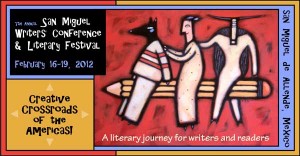 Last year, I fell into it at the last minute. This year I came prepared to deliver, at San Miguel Writers’ Conference, a 90-minute workshop on “Self-Publishing Success.” My overview of the rapidly-changing world of print on demand (POD), eBooks and online marketing was well-received by 40 gracious and eager learners.
Last year, I fell into it at the last minute. This year I came prepared to deliver, at San Miguel Writers’ Conference, a 90-minute workshop on “Self-Publishing Success.” My overview of the rapidly-changing world of print on demand (POD), eBooks and online marketing was well-received by 40 gracious and eager learners.
I shared what I discovered in publishing”Leonardo’s Revenge and Other Stories” – in the week between Christmas and New Years Day, without spending a penny – my encouragement to get it done, and my suggestions of where to spend money on professional help: editing, cover design and a well-conceived marketing plan so as to stand out among the three-million-plus eBooks expected to be published in 2012. I also uploaded a number of resources to this site for those interested in self-publishing (feel free to pass along!).
By all accounts, the 7th Annual Conference was the best yet! Bigger, better and exceptionally well organized, the four jammed-packed days in mid-February provided authors and readers a plethora of workshops, classes, panel discussions, readings and lectures. For me, the highlight was Margaret Atwood’s keynote address, “Writing and Hope,” attended by more than 800 people, both residents and visitors to San Miguel.

Margaret Atwood, a Canadian National Treasure and author of more than 40 books of fiction, poetry, and critical essays, spoke of hope as “a human constant and a literary concept. As writers, we cannot possibly succeed unless we have hope… hope we’ll finish a book, find a publisher, and the publisher last long enough for the book to come out; and hope someone will buy it, read it, and understand and/or like it. That’s a lot of hope!”
With grace and wit, she traced her history as a woman author in light of social changes over the past five decades, starting with “Edible Women” published in 1969: “In those days, I was often asked, ‘Do you hate men?’ to which I’d responded, ‘Which ones?’ When vacuous reporters asked, ‘Is your hair really like that or do you get it done?’ I’d say, ‘If I were going to get it done, would I do this?'” (Sharing a similar relationship to my unruly hair, I had to laugh!)
In a beautifully balanced discourse of light and darkness, Ms. Atwood raised the question of hope regarding human rights and environmental issues – major issues of our time and her passions – noting we rightly fear for the economy, the planet, our children, and the civil rights we once took for granted. She concluded, “We are readers and writers embedded in time.”
In regard to her dystopian books, that she refers to as “speculative fiction,” “”Handmaiden’s Tale”, “Oryx and Crake” and “Year of the Flood”, Atwood addressed possible, scary futures such as “theocracy, and contraception in all its forms” – who can have children, who are denied them, who must have them, who gets to steal the children of others, who creates canon fodder – adding, “I did not intend [my books] to function as a blueprint for Republicans.”
In Atwood’s insightful world, “Writing is the coding of human voice into symbols. Reading is the decoding of symbols (like music). Readers are playing your symbols; it’s not passive. Human voice and language – it is us and we are it.” But, there is always the dark side: “Those in power control language. They think, ‘if it can’t be said, then it can’t be thought, and it can be made to disappear.'” She asked us to consider examples, such as recent laws of unbridled snooping, and labeling environmentalists “terrorists” when, in fact, “it’s all about the oil!” As soon as those emphatic words were out of her mouth, a boom of thunder shook the conference hall. Without missing a beat, Ms. Atwood calmly proclaimed, “I love punctuation!”
Among many global concerns and challenges, she spoke of the disappearance and murder of journalists “brave enough to write about drug violence. Mexico deserves better! Writers must be free to use their human voices without being martyred.” She ended her beautifully-crafted speech with a final insight into hope: “Hope imagines things can be better than they are.”
The next day, passing Ms. Atwood on the grounds of the Hotel Real de Minas, where the conference was held, I thanked her, saying, “That was the best keynote speech I’ve ever heard.” To which she replied, eyes twinkling, “If that’s the case, we’re in trouble!” We both laughed and moved on. I felt hope… hope that I might realize my aspiration to be such an elegant, lively, passionate and brilliant writer and speaker as Margaret Atwood.
With another successful event behind them, Director Susan Page and the executive committee are already planning for 2013. I have submitted my proposal to again present on self-publishing and marketing, and hope to be invited back to this extraordinarily fun and inspiring conference.
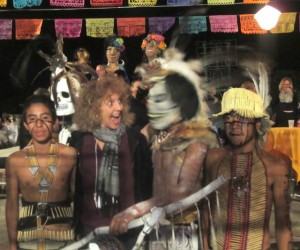
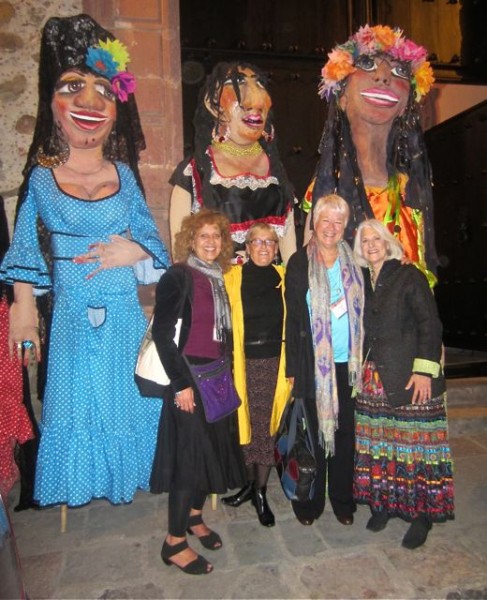

Last week I had the extraordinary experience of being 19 years old again.
As a gringa living in San Miguel de Allende (SMA), in the state of Guanajuato in central Mexico, I am often asked: “Is this your first time here?” While my last time was earlier in 2011 (see January and February archives), my first time was actually in 1974, at the age of 19. I had spent five days in SMA, en route to explore other parts of Mexico, after living and working for some months in the nearby colonial city of Guanajuato. This past winter, while in SMA for 8 glorious weeks, I had thought to make the one-hour bus trip to revisit Guanajuato after 37 years, but I simply did not do it, and might have continued avoiding my past, had it not been for a friend, author Susan Cobb, who made a date to accompany me.
Before I recount what I discovered on this recent trip, permit me to tell you how I came to live in Guanajuato in the first place: After working all summer of 1974 in Vail, CO, I managed to save a whopping $400, which was not sufficient funds to return to University of New Mexico in Albuquerque, where I had completed a year of credit. Instead, I decided to go to Mexico where, I figured, I could have a grand adventure for cheap and practice Spanish, which I had studied throughout junior and senior high school.
In that very different, less fearful world of 1974, I gave no thought to hitchhiking from Denver to El Paso, walking across the international footbridge into Ciudad Juarez for 2¢, and boarding a Chihuaheses (Greyhound) bus south. I didn’t have a guide book or even a map, and no idea of a destination. When I couldn’t stand being on the bus a moment longer, I got off and, as good fortune would have it, I was in Guanajuato; arguably the most beautiful and colorful city in Mexico. 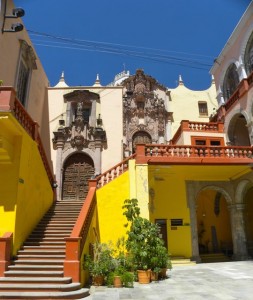
It is both a historic city – famous for its wealth from nearby silver mines that created splendid examples of colonial architecture and playing a major role in The Mexican War of Independence (1810-1821) – and a cultural center – with the Teatro Juarez (see images), la Universidad, the Cervatino Festival each October (that I experienced in its 2nd year, from the rooftop of the pension in which I lived right in Plaza San Roque) and a World Heritage Site designation in 1988.
Memories, at least for me, seemed to be stored in the stories I have kept and retold, and after 37 years and many travels and adventures in the interim, I was assailed, upon reentering the historic central zone of the city, by a flood of forgotten memories.
Upon entering the grand Mercado, I recalled conversations and bargaining for wooden utensils, terracotta bowls, fruits and vegetables. In those days it was normal to bargain for everything.

On the street in front, the perennial hawkers and vendors seemed like the same ones from decades before, perhaps the sons and daughters of those I had seen. I imagined the layout of the hotel I had stayed in nearby, for a week, where I encountered a giant scorpion for the first time. “Don’t worry,” said the owner in response to my screams of terror, “It’s a big one. You only need to be careful with the small ones.” Although not reassured, I was enchanted by the new and foreign world into which I had cast myself.
Susan and I wandered amid outrageously colorful buildings on winding stone streets full of college-age students, just as when I was there. In my mind’s eye I could see the actual faces of my friends and recalled Beatles songs that had been sung to me in the Jardin by eager young men with guitars, wanting to impress with their only knowledge of English.
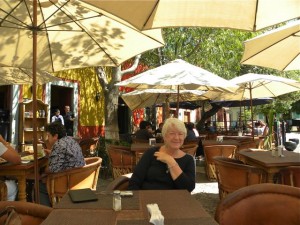
The students walked purposefully, having places to go and friends to meet up with. I remembered how it felt to live there, to be 19 and have friends with whom to engage in late night philosophical conversations in bars and then to trudge up steep alleyways to the only cheap quesadilla joint still open at 2 or 3 a.m. I thought about how we are all in our 50s now, having lived essentially whole lives… jobs, careers, marriages, children, dreams fulfilled, or not. And, no doubt, some had already died, or suffered major illnesses and accidents.
There was no point in wondering what had unfolded for Alfredo, a large and friendly fellow whose slight by feisty madre owned the pension, or “Dirty Panther,” my funny curly-haired boyfriend whose real name was Jesus, or Marianna, my housemate who had been a belly dancer in San Francisco, as we did not keep in touch after I left. Long-distance communications were difficult and expensive in 1974.
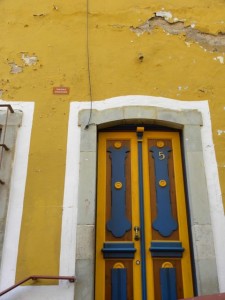
But I reflected on my life and the young woman who, with no one to be responsible to or care where I was, made friends, found enjoyable work, and was courageous and present for life’s grand adventures. I realized that I am the same person I was at 19 who still does not know what lies ahead, as we never do… despite the delusion of all our planning and goal setting.
Yes, of course I now have more knowledge and wrinkles, but it’s not what we acquire that matters; what’s important is what we leave behind. I hope that I am leaving a trail of kindness and encouragement. We are all just passing through…
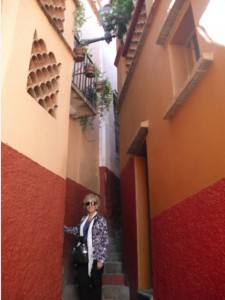
After an emotional day revisting a beautiful place I once lived, I concluded that if the wondrous and predominantly benevolent experiences of my past are any indication, there is no reason to fear the future. As a Mexican boy once sang to me in the Guanajuato Jardin, “All you need is love.”
A few weeks ago, I published a personal experience article, “Is It Safe To Visit Mexico?“. Being a very “hot topic,” it received thousands of hits and some lively comments, mostly appreciating the balanced picture I presented. Here, In his “Notes from the Field,” (March 8, 2011), Simon Black, the international business-savvy “Sovereign Man”, dives deeper into the topic in his report from Merida, Mexico. I have a great deal of respect for Simon’s insights and opinions. You can read this article and many more by Sovereign Man at: http://www.sovereignman.com/expat/mexicos-biggest-problem-is-the-us-government/
I’m leaving Mexico.
No, it’s not because I’ve been robbed, beaten, or kidnapped by the drug cartels. And it’s not because some corrupt policias tried to shake me down, because I contracted swine flu, or that beheaded bodies were left in the street outside of my hotel.
Honestly, I’m really enjoying it down here and would like to stay, but I have some important meetings in New York later this week, so I will unfortunately be headed north to brave the cold weather and even colder reception at US immigration.
Before I leave Mexico, though, I want to address the elephant in the room: Mexico’s infamous drug war, probably the most sensationalized, misunderstood issues played out in North American media, right between Charlie Sheen and Lindsay Lohan.
The bottom line is that two governments decided long ago that drugs are a problem and that they need to do something about it. On one hand, the Mexican government expects the US to reduce demand, and on the other hand, the US government expects Mexico to curtail supply.
There are three major problems with this logic.
First is that the governments think they can force the reduction of something that literally grows on trees. Marijuana and cocaine are more easily grown than Ben Bernanke’s balance sheet– they’d have better luck reducing the supply of stupidity and hypocrisy in Washington.
What most people don’t realize is that they’ve carpet-bombed half of Colombia with herbicides so nasty (thank you, Monsanto) that they make Agent Orange look like a stick of deodorant. And yet, the cartels still find plenty of land to increase their productive capacity.
Fighting a multi-decade war against plants is just a dumb idea, ranking up there with other such gems as spending our way out of recession, borrowing our way out of debt, and invading other countries to reduce hatred against America.
The second problem is that these governments actually expect to be able to suppress demand. This is nonsense.
There will always be certain personalities who will seek out the high of recreational drugs despite the consequences. Similarly, there are certain personalities who will gamble despite the losses, seek adrenaline rushes despite the risks, or eat Big Macs despite what the bathroom scale says.
To those personalities, their desires are as natural as the instinct to breathe.
There’s no great mystery in the world about the effects of recreational drugs. As dealers say, ‘drugs sell themselves’. Drug users accept the risks because they think the benefits are greater, or they’re psychologically and/or chemically addicted to the product.
This is no different than people who’ve become addicted to aspartame (Diet Coke), prescription pills, sex, booze, exercise, cigarettes, work, shopping, anger, pain, video games, junk food, etc. The chemical and psychological dependencies don’t vanish just because the government decrees it.
The third problem is that the governments even began with the false premise that recreational drugs are a problem and should be prohibited. This is intellectually dishonest: governments sanction all sorts of drug use.
The US government says, for example, that nicotine, high fructose corn syrup, partially hydrogenated soybean oil, alcohol, Viagra, aspartame, Prozac, and Yellow #5 are OK, but raw milk, Cuban cigars, marijuana, human growth hormone, and chocolate Kinder eggs are not OK.
Look, I’m not trying to be anti-alcohol or pro-Kinder egg, but the notion that government agencies should be able to choose which substances we grown adults are and are not allowed to buy and ingest is rather anachronistic. And they do a horrible job at it anyhow.
The FDA is constantly having to recall products that it had approved, frequently reversing its own GRAS (generally regarded as safe) decisions. Remember Vioxx? Stevia? Avastin? Ephedra?
The agency is filled with pencil-pushing bureaucrats who endlessly circulate position papers, dragging on the approval process for potentially life-saving drugs so that someone who’s already dying of cancer won’t have an adverse reaction.
It’s a fundamental injustice when a corrupt bureaucracy swayed by powerful lobby groups is able to decide what we can put in our own bodies, and then fails miserably at enforcing its own vacuous regulations.
The end result of this fallacy has been playing out in Mexico. Yes, there is violence and crime in Mexico related to the business of transporting and distributing recreational drugs. The violence is often portrayed in the media as ‘turf wars’ between competing cartels.
This sounds good, but it’s not really true. There are far more customers out there than the cartels can possibly supply. Fighting for demand is not the issue… it’s getting supply to the customers.
As such, cartels are either duking it out with each other over key supply routes (which is why most of the violence is in the border towns), or they’re battling the government forces trying to interdict them.
Funny thing, Pfizer and Lily don’t shoot it out in the streets over shelf space for Viagra vs. Cialis. War is bad for business; it’s prohibition that induces armed defense of logistics hubs and production facilities.
The real scourge on Mexican society isn’t ‘turf war’ shoot outs, but the de facto police state that now exists.
In daily life, the chances of the average Mexican coming into contact with drug-related crime or violence is very low. The chances of being harassed or disrupted by government paramilitaries brandishing automatic weapons in full combat gear is extremely high.
To give you an example, I woke up at our beach home in Tulum last week to a squad of Mexican military patrolling the beach in formation, their weapons ‘at the ready.’ Later in the day they set up check points on the road to harass anyone who wasn’t white.
Airports are even worse– multiple baggage searches, pat downs, drug dogs, roving infantry squads… all making it more difficult for tourists and legitimate travelers to get in and out of the country.
This is the fundamental issue in Mexico– billions of dollars from the US are fueling a war on plants and human nature fuels violence and creates a police state.
The violence (mostly localized in border towns) will continue until these countries finally go broke, capitulate, and begin the embarrassing process of reexamining their policies.
Simon Black
Senior Editor, SovereignMan.com
